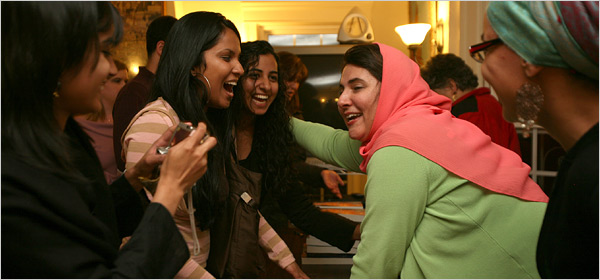Preachy as she is, Aunty Mohja is not out to convert you to traditional Islamic dress, only to that root of its ethos that’s a basic right and blessing for all. Her to-do list is pragmatic, tailored to a secular American populace. Observant Muslims, be prepared that her Rules will not, therefore, be up to hijab standards. And to the midriff-baring girls Aunty Mohja sees at the Mecca Mall in Amman, Jordan, don’t throw the baby (of basic decency) out with the bathwater (of the veiling you choose not to do).
Who says Muslims are wrong about veiling? Honey, of course we’re right, Aunty Mohja says. The privacy of the crotch, the sanctity of the small of the back, and just plain physical dignity, those are some of the fruits of body modesty, and part of what sets us apart from species whose knuckles scrape the ground.
The hairy knees of the man beside me on the airplane and the tissue folded into the butt-cleavage of Aunty Mohja’s hometown coffee barista say that this civilized human trait can be drummed out of people. Bit by bit, through neglect, or deliberately, by embrace of the nutty notion that naked means free. Or by fashion and garment industries bizarrely out of touch with our elemental need for clothing that clothes us.
Speckled old thighs, for example, male or female be they, have presumably done some service in the world and are due respect, and sorry, they just don’t get it in Bermuda shorts, a garment invented for young British soldiers suffering the heat of empire at the turn of the twentieth century.
American society is at a loss for modesty, and Muslims are here to help. Aunty Mohja will show you how to take a leaf from our book of bodily modesty. For less tangible forms of modesty, you’re on your own. Aunty Mohja is not the best at working out modesty-of-the-self issues.
You may fear that Aunty Mohja wants you to veil. Rest easy. Preachy as she is, she is not out to convert you to traditional Islamic dress, only to that root of its ethos that’s a basic right and blessing for all humankind. Her to-do list is pragmatic, tailored to a secular American populace. Observant Muslims, be prepared that her Rules will not, therefore, be up to hijab standards. And you Muslim backsliders, like the midriff-baring girls Aunty Mohja sees at the Mecca Mall in Amman, Jordan, don’t throw the baby (of basic decency) out with the bathwater (of the veiling you choose not to do).
And yes, some Muslims go overboard with the coverage. As we say in Arabic, could we blend the two extremes together and split the mix down the middle? Meaning, we each have something to learn from one another. Aunty Mohja normally doesn’t give a hoot about building anything as clichéd as “bridges between cultures” but grudgingly admits that this may be one.
Listen: If you live in a clothing-optional community, go and enjoy your choice, and stop reading this. Revel in your nakedness. Aunty Mohja only prays you don’t get poison ivy in a hard-to-itch part of you.
The rest of you, who live in the world of clothed people, let’s get started. Aunty Mohja will break it down into four body zones for you. In Part 1, Aunty Mohja will discuss:
1. Crotch Care
2. Midriff Matters
In Part 2, to be featured on Altmuslimah on Friday, Aunty Mohja will cover:
3. Thigh-high Thoroughfares
4. Breasts and Upper Body Bareness
1. Crotch Care
When little Aunty Mohja dangled upside down from the jungle gym at five years old with peanut-butter-and-jelly smudged hands, her daisy dress hanging around her ears, her loose terrycloth underpants flashed the playground population. Her mother handed her a pair of daisy shorts. “Always keep your pee-pee well-covered,” said Mama in her wisdom.
Aunty Mohja clearly sees that tons of Americans never get from their parents this basic, self-protective teaching, known to most humanity since Eve and Adam donned fig leaves. Your Aunty Mohja is here to fill in the gap in your upbringing: make sure the leaves cover the figs.
This means, if you’re sitting, legs apart, at the top of the steps at the New York Public Library, check that you aren’t giving 5th Avenue a view of the figs. Note that most men’s shorts are cut wide in the leg, and since men often sit with legs open, they may be offering a side-window view unawares. Never mind how Aunty Mohja knows this! As for women’s figs, Aunty Mohja believes that clothing manufacturers conspire to make sure a woman’s clothing is always in danger of giving a peep show. She urges women to organized resistance through alterations.
Different protocols perhaps apply if you’re a celebrity actor and see body display as part of your role, although our classier actors keep something in reserve. But the ordinary men and women I’m describing would be horrified that random sundry got a glimpse of their nesting pigeons. Yet they lack the skills to prevent such predicaments. Learn them from your aunty.
Special section: Crotch Care at the Beach or Pool:
Darlings, please check that your suit’s fabric doesn’t show through to your bush. Does no one ever tell the youth of America this? In fact, why not follow the sunnah of all the Prophets and clip your lawn. I’m talking to men and women, both. You don’t want to get gristly. There or in the armpits. This isn’t Europe, thank God.
It is too much, I suppose, to expect American women to change the basic contours of their customary swimsuit, which favors the teeny-beeny triangle bikini notion of crotch coverage, rather than the Muslim idea that the crotch extends from the navel to the knee (for men and women both). Aunty Mohja favors the more graceful, kinder to the crotch and tush, bathing outfits from the 1920s, or at least the 1950s—thankfully, some of those are back. Most American men, to their credit, have the sense not to do itsy-bitsy tight male- panty swimsuits—it’s (Aunty Mohja will say it out loud) the Chinese men at the pool who seem stuck on those. Aunty Mohja prefers the more decorous boxer swim trunks for men and boys.
And remember, no one said the only option is the contemporary Western swimsuit—the majority seem designed to compliment only a tiny fraction of human bodies. We Muslims need not be ashamed (how odd, that some people think it a shame) to wear more generous swim outfits, such as suits with skirts, spandex jumpers, and yes, even the burkini. Muslims invented leisure bathing after all, in the Middle Ages when Latin Christendom looked down on it as worldly, and we have a rich history with sarongs and bathing cover-ups. We don’t come from a tradition of repression of the body, like the Victorian legacy Americans still seem to think they must valiantly fend off, the one they see lurking in every admonition to modesty. We come from a tradition of honoring the body and cultivating beauty and intimacy and eros—not at random in public, but in a proper, private setting.
2. Midriff Matters
If you are a sari-wearing woman in India, Pakistan, or Bangladesh, and bare your midriff, well, there, it is customary and respectable in many quarters. Here in the U.S., a bare midriff is not appropriate in most business and school contexts. Aunty Mohja wants to know what goes on in the minds of these parents who send their children to high school with bare love handles. She compassionately understands that many of these boys and girls are emotional orphans, whether of poverty or privilege. Others are little dictators before whom spineless parents have surrendered authority.
Next, we have the pudge. It’s that natural underbelly which rises just at the top of the “bikini line” (known to some of us as the Caesarian-section scar). Pudges are cute, ladies. Don’t let anyone make you think your pudge needs to be flattened. Pudges make us women, not washboards. And Aunty Mohja says, don’t show your pudge to anyone who wouldn’t be willing to kiss it. That’s the intimacy level where pudge belongs.
Guys may not have pudge, but we don’t want to see their pubic bones. Pull those pants up! Think of the 1940s waistline, gentlemen! It was good enough for Aunty Mohja’s grandfather, and it’s good enough for you.
Regarding butt cracks, one word: NEVER.
All this takes continuous effort, sweetie, I know. Clothing manufacturers are making the pants so low-rise that, the minute you bend, sit down, or raise your arms, there’s booty to pay. Yet the precious portion of our selves between our nether cheeks is not meant for public perusal. It takes wardrobe coordination. If your pants sit low, wear a top that tucks in or a layer that goes well over them. Do it for the children.
And don’t do it with thongs. Turning underpanties into outerwear is never the answer. Take this from a woman of Damascus, a city that has specialized in delectable undergarments for over a hundred years, but has kept them inside the boudoir.
The lumbar region, the solar plexis, the belly button, the sacrum, these are not body zones that typically command a lot of respect, so at least do them the kindness of not making them vulnerable to indifferent eyes. Also, this part of us really only looks good for fifteen minutes of youthful prime, unless you buy into a personal trainer and a lot of unnecessary surgery. Anyone who urges you to bare it after that is not your friend.
In fact, so much unnecessary surgery and dysfunctional body attitudes and heartache could be saved if American culture accepted what Muslim culture has always known: these parts of our bodies are not meant to be exposed to constant public scrutiny. Scrutiny at the gym! the grocery! out on the town! Nay. Drape them with the dignity of a little more privacy, and we’ll all live more contented lives.
(Photo: Hopeless128)
Aunty Mohja is an oddball relative who visits Professor Mohja Kahf from time to time, and gives her stuff to publish. Aunty Mohja is preachy, bossy, snotty, catty, and uppity, and already knows it. And she generalizes freely about Americans. And Muslims. Aunty Mohja tries to work in some hot fudge generalizing every morning with coffee. Do not ask her boring academic relative, the professor with the same first name, to account for her.
Mohja Kahf is a celebrated poet, novelist and a faculty member in the University of Arkansas’s King Fahd Center for Middle East & Islamic Studies.
This post was originally published on October 7, 2009.






2 Comments